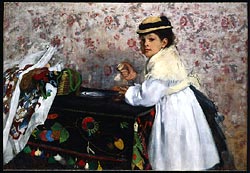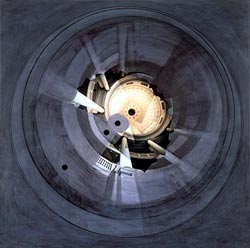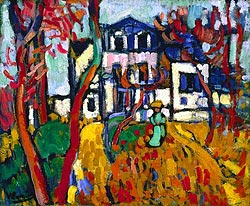 |
 |
 |
 |
 |
In this painting, represented texture plays an important part in creating asymmetrical balance. The figure of the girl
wears a black dress covered by a smooth white smock and a soft white shawl. The texture of the colorful embroideries to the viewer's left
balances the smooth surfaces of the young girl's clothing. |
 |
Hilaire Germain Edgar Degas
Portrait of Mademoiselle Hortense Valpinçon
About 1871
Oil on mattress ticking
The Minneapolis Institute of Arts
The John R. Van Derlip Fund

|
|
 |
 |
 |
 |
 |
|
 |
 |
 |
 |
 |
Removing the main figure reveals the large, lush textural background that Degas used to counterbalance the figure. |
 |
Hilaire Germain Edgar Degas
Portrait of Mademoiselle Hortense Valpinçon with main figure removed
About 1871
Oil on mattress ticking
The Minneapolis Institute of Arts
The John R. Van Derlip Fund

|
|
 |
 |
 |
 |
 |
|
 |
 |
 |
 |
 |
This asymmetrical composition is organized around a diagonal axis. The red square at the lower right is balanced by the
large amount of white space in the upper portion of the painting. The parallel black diagonal lines near the top of the composition create
tension between shapes and space. |
 |
Jean-Albert Gorin
Composition #37
1937
Oil on wood
Walker Art Center
T.B. Walker Foundation Acquisition, Gift of Archie D. and Bertha H. Walker Foundation

|
|
 |
 |
 |
 |
 |
|
 |
 |
 |
 |
 |
This composition is arranged around a center point, like the spokes of a bicycle wheel or the rays of the sun. This is
called radial balance. |
 |
Jan Dibbets
Cupola
1985-1986
Color photographs, watercolor, pencil, glass pencil on paper mounted on chipboard
Walker Art Center
Walker Special Purchase Fund, 1988

|
|
 |
 |
 |
 |
 |
|
 |
 |
 |
 |
 |
In the five-pronged star at the center of this basket we see another interpretation of the sun, radiating out toward the
edges. The radial design is an integral part of the way the basket was woven. |
 |
Pima
Coiled Basket
19th-20th century
Plant fibers
The Minneapolis Institute of Arts
The Ethel Morrison Van Derlip Fund

|
|
 |
 |
 |
 |
 |
|
 |
 |
 |
 |
 |
Various methods of achieving balance can be discussed separately, but in fact artists usually use several of them together.
In this painting balance is achieved through equal amounts of contrasting, complementary colors, the centrally placed house, and the even
distribution of brushstrokes across the entire canvas. |
 |
Maurice de Vlaminck
The Blue House
1906
Oil on canvas
The Minneapolis Institute of Arts
Bequest of Putnam Dana McMillan

|
|
 |
 |
 |
 |
 |









